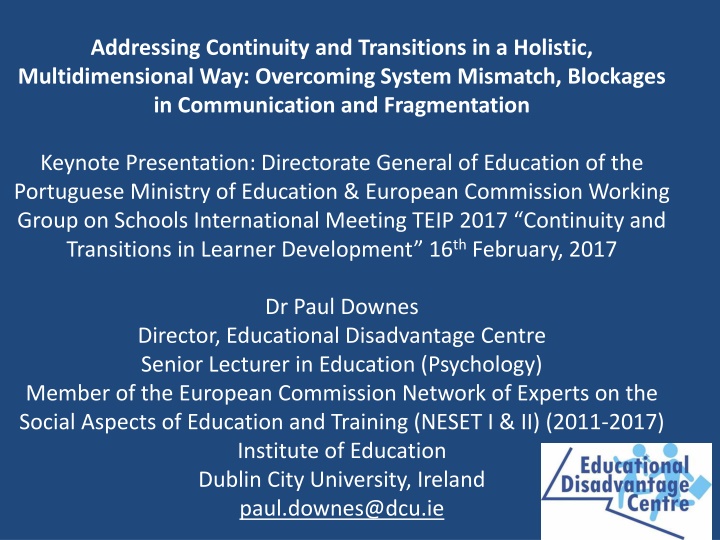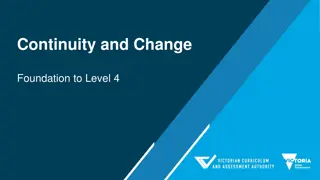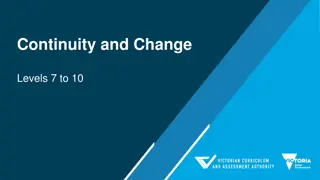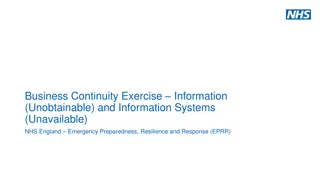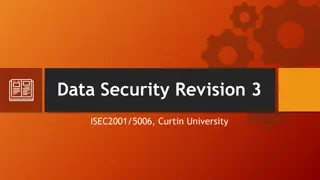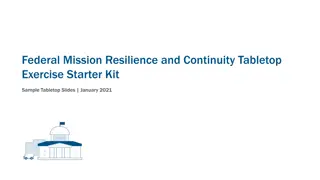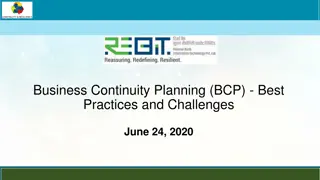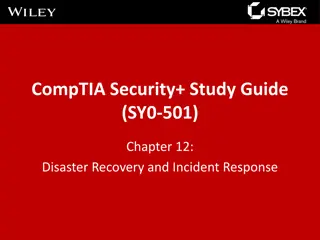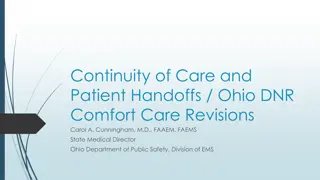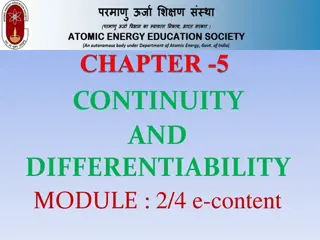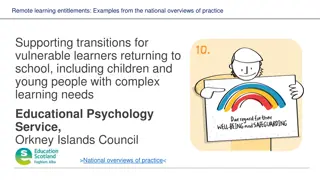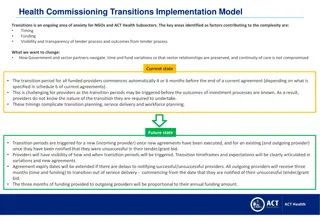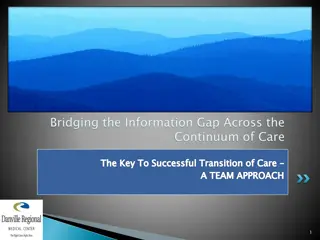Addressing Continuity and Transitions in Education Systems
Overcoming challenges in education transitions requires a holistic, multidimensional approach to address system mismatch, communication blockages, and fragmentation. Strategies for learner development, inclusive supports, and preventing early school leaving are vital. Progress in Portugal shows improvement in ESL rates. Rethinking transitions as responsive, inclusive systems goes beyond individual focus to address system mismatches, blockages, and fragmentation in education settings.
Download Presentation

Please find below an Image/Link to download the presentation.
The content on the website is provided AS IS for your information and personal use only. It may not be sold, licensed, or shared on other websites without obtaining consent from the author.If you encounter any issues during the download, it is possible that the publisher has removed the file from their server.
You are allowed to download the files provided on this website for personal or commercial use, subject to the condition that they are used lawfully. All files are the property of their respective owners.
The content on the website is provided AS IS for your information and personal use only. It may not be sold, licensed, or shared on other websites without obtaining consent from the author.
E N D
Presentation Transcript
Addressing Continuity and Transitions in a Holistic, Multidimensional Way: Overcoming System Mismatch, Blockages in Communication and Fragmentation Keynote Presentation: Directorate General of Education of the Portuguese Ministry of Education & European Commission Working Group on Schools International Meeting TEIP 2017 Continuity and Transitions in Learner Development 16th February, 2017 Dr Paul Downes Director, Educational Disadvantage Centre Senior Lecturer in Education (Psychology) Member of the European Commission Network of Experts on the Social Aspects of Education and Training (NESET I & II) (2011-2017) Institute of Education Dublin City University, Ireland paul.downes@dcu.ie
Multidimensional Holistic Strategies in Place for Transitions Problems of transition need recognition as being multidimensional regarding not only the intensity of the needs of students but also the kind of need: academic supports, peer relations, relations with teachers, mental health and wellbeing, behaviour difficulties, nonattendance at school, bullying and safety motivation physical needs (sleep, hunger) Though multidimensional, issues such as bullying and early school leaving prevention can be addressed through common system sets of supports (Downes & Cefai 2016) for inclusive systems (Downes, Nairz-Wirth & Rusinaite 2017) as part of a quality focus
Portugal Progress being made on ESL Early School Leaving Rate 2012: 20.8% Early School Leaving Rate 2014 17.4% (Eurostat 2015) EU2020 headline target: 10% * Not one ESL Problem
Rethinking Transitions in Systems as the need for responsive inclusive systems beyond Bronfenbrenner (1979, 1995) and beyond a reduction of transition to the individual 1. System Mismatch between 2 Well functioning Systems 2. System Blockage (Downes 2014) in Communication 3. System Mismatch where at least one system needs reform the bridge is not the problem 4. Beyond System Fragmentation: Early Warning Systems and Transitions 5. Multidimensional Strategies in Place
1. System Mismatch between two Well Functioning Systems Cadima et al (2015) Belgium - 145 children and their kindergarten and first-grade teachers Closer teacher child relationships and lower levels of perceived peer teacher conflict contributed to higher levels of behavioral engagement in kindergarten This in turn was associated with both higher levels of observed and teacher-reported engagement in first grade.
observed classroom organization was positively related to children s observed behavioral engagement. The average engagement observed in first grade was likely to be higher in classrooms offering higher levels of classroom organization quality.
Cadima et al (2015) Belgium Children with higher levels of behavioral engagement in kindergarten attending classrooms with higher levels of classroom organization were observed and reported by teachers as more engaged in first grade it appears that self-regulation skills, such as paying attention, waiting for his/her turn, inhibiting off-task behavior may help children to respond to the demands of the classroom.
Relational Dimensions Cadima et al 2015 It is possible that children with closer relationships may be more willing to learn effective ways to behave in the classroom. Children were observed to be more engaged in classrooms where teachers used: - proactive behavior management strategies, - established predictable routines - made a productive use of time. Those strategies appeared to help children to spend more time in the activities, i.e pupil motivation and concentration
2. System Blockage in Communication Hopwood et al. (2016) Australia: one-on-one interviews with primary (Year 6) and secondary (Year 7) teachers. three key methods : curriculum continuity and awareness, communication between primary and secondary schools, and adequate teacher support. The primary teachers revealed that their role in preparing students for secondary school was passive, based around accommodating requests from the secondary schools.
The primary teachers also reported little or no input into the way students were prepared for transition, as one primary teacher explained: We talk about what they might experience at secondary school but I don t do anything specific to deal with teaching them about secondary school [Primary Teacher 4]. Unlike the primary teachers, the secondary teachers assumed an active role in preparing students for transition.
Hopwood et al. (2016) Although the secondary teachers had a structured approach to transition, the teacher data also revealed that methods of preparation were focused on preparing students for the physical and structural aspects of secondary school rather than the academic demands of Year 7. All primary school teachers and 71 % of the secondary school teachers felt that an increase in communication was needed between primary and secondary staff in relation to the transition phase. But a Proportionality Principle ?? Need to distinguish levels of need All primary teachers and all secondary teachers felt that running consistent programmes between the schools and being familiar with the curriculum was essential.
Teacher support was the main contributing factor in enabling them to support students more effectively throughout the transition phase -all of the primary and secondary teachers reporting that adequate teacher support was essential for transition success. Teacher support referred to: - the types of resources available to assist teachers, including access to age appropriate resources, - teacher s aides to work with students in the classroom, - increased planning time, - support from colleagues and - opportunities to attend professional development days.
Hopwood et al. (2016) Australia: Secondary teachers words, For resources, more levelled specific texts that are not out-dated and more books for the kids to read that are not little kid s books The results revealed a concerning trend indicating that the types of programmes and practices used by primary and secondary school teachers were somewhat inconsistent, pointing to a disparity in how the two school systems prepared their students for transition.
Hopwood et al. (2016) A common misunderstanding about transition preparation that was identified in this research is that transition preparation is the sole responsibility of secondary schools. Ensuring that Year 6 and Year 7 teachers are familiar with the curriculum taught in each year level. For example, Year 6 teachers acquiring knowledge of the Year 7 curriculum and Year 7 teachers acquiring knowledge of the Year 6 curriculum 100% Primary and Postprimary teachers
3. System Mismatch where at least one system needs reform: Is it the destination rather than the bridge that is the problem ?
System Mismatch where at least one system needs reform: Transition as Derivative Problem from a More Fundamental Problematic System Area of School Climate or Environment Fish out of Water or Polluted River ? Is the Transition the Problem or is it the School Environment ? Systems framework of Bronfenbrenner (1979, 1995) overlooks system blockage (Downes 2014) Authoritarian School Climate Bullying Environment Poor Working Conditions for VET Placements (Cedefop 2016)
Western Cognitive Bias: Individual Foreground Perception Neglects Background System Masuda and Nisbett (2001) presented realistic animated scenes of fish and other underwater objects to Japanese and Americans and asked them to report what they had seen. *The first statement by American participants usually referred to the focal fish ( there was what looked like a trout swimming to the right ) whereas the first statement by Japanese participants usually referred to background elements ( there was a lake or pond ). *Japanese participants made about 70 percent more statements about background aspects of the environment.
Masuda and Nisbett (2001) In a subsequent recognition task, Japanese performance was weakened by showing the focal fish with the wrong background, indicating that the perception of the object had been intimately linked with the field in which it had appeared. *In contrast, American recognition of the object was unaffected by the wrong background Foreground Child Background system - School
Transition as Derivative Problem from a More Fundamental Problematic Area of School Climate Recent concern with school climate as key to transition to secondary school (Madjar & Cohen-Malayev 2016) and central to preschool-primary transition (Cadima et al. 2015) West et al. (2010) study of over 200 Scottish pupils students with lower ability and lower self-esteem had more negative school transition experiences which led to lower levels of attainment and higher levels of depression. Also anxious students experienced bullying
Authoritarian Teaching Downes (2004) Have anger management courses for teachers (Secondary, F, FG) The teachers shouting at you. That makes me really really down (Age 13, F, Q) if the teachers didn t roar at you (Age 13, F, Q) - Have an equal teaching system and sack ignorant snobby teachers very harsh teachers usually make me stay out of school (Age 16, M, Q)
Marginalised students voices, transition and classroom climate Downes, Maunsell & Ivers (2006): Approximately 74% of pupils at primary level (6th class) state that they are treated fairly by teachers in school Approximately 55% of students at secondary level (first year) state that they are treated fairly by teachers in school- Approximately 15% of pupils at primary level (6th class) state that they are not treated fairly by teachers in school- Approximately 25% of students at secondary level (first year) state that they are not treated fairly by teachers in school *These differences between 6th class primary and 1st year secondary are statistically significant i.e., there is a statistically significant increase in perception of being treated unfairly by teachers in secondary school compared to primary school.
Lester and Cross (2015) 1800 students aged 1114 In the last year of primary school, peer support was the strongest protective predictor of wellbeing, while feeling less connected and less safe at school predicted lack of mental wellbeing. Feeling safe at school was the strongest protective factor for student wellbeing in the first year of secondary school. In the second year of secondary school, peer support was the strongest protective factor for mental wellbeing, while feeling safe at school, feeling connected to school and having support from peers were predictive of emotional wellbeing. School policies and practices promoting safety and encouraging and enabling connectedness are important during the first years of secondary school.
Gniewosz et al. (2011) refer to a lot of structural changes in transition to secondary school a stronger emphasis on teacher authority, ability grouping, less autonomy which do not fit the developmental changes starting around puberty, namely the intensified need for autonomy Five common school climate domains have previously been identified: order, safety, and discipline; academic outcomes; social relationships; school facilities; and school connectedness (Zullig, Koopman, Patton, & Ubbes, 2010).
Lester and Cross (2015) Depression, anxiety, emotional problems, conduct problems and total difficulties significantly increased after the transition into secondary school, whereas peer problems and pro-social tendencies significantly decreased after the transition into secondary school. School connectedness was the most significant protective factor against depression , while peer support was the most significant predictor against anxiety Feeling safe at school includes social-emotional safety, physical safety, and substance use (Bradshaw, Waasdorp, Debnam, & Johnson, 2014)
Percentage of Socioeconomically Disadvantaged Students who Agree/Disagree with the Following Statements: School Belonging and Feeling Like an Outsider (PISA 2012) (OECD 2012) I feel like an outsider (or left out of things at school), % Disagree (S.E) 89.9 (1.1) 88.4 (1.0) 80.5 (1.6) 90.3 (1.0) 90.0 (1.3) 89.2 (1.0) 73.2 (1.8) 89.7 (1.4) 83.9 (1.4) 85.6 (1.6) 91.6 (1.0) 89.3 (0.6) 85.9 (1.2) 89.8 (1.3) 89.1 (1.0) I feel like I belong at school, % Agree (S.E) Countries Austria Belgium Czech Republic Denmark Estonia Finland France Germany Greece Hungary Ireland Italy Luxembourg Netherlands Norway 82 (1.6) 63.5 (1.6) 73.6 (1.9) 69.3 (1.6) 78.2 (1.8) 80.5 (1.1) 38 (1.7) 83.8 (1.6) 87.8 (1.2) 83.5 (1.1) 76.7 (1.5) 75 (0.9) 71.9 (1.7) 82.4 (1.7) 83.5 (1.5)
Poland Portugal Slovak Republic 73.2 (1.8) 87.9 (1.2) 75.4 (1.8) 88.2 (1.3) 87.4 (1.5) 74.0 (2.3) Slovenia Spain Sweden United Kingdom OECD Average 83.7 (1.7) 92.1 (0.7) 74.8 (1.9) 74.9 (1.5) 78.1 (0.3) 89.0 (1.2) 90.1 (1.0) 87.0 (1.3) 86.9 (1.1) 86.2 (0.2)
4. Beyond System Fragmentation: Early Warning Systems and Transitions Absences in elementary grades were linked with markedly unfavorable outcomes on standardized tests of reading and mathematics (Gottfried, 2009). The US National Center for Children in Poverty conducted a large study of chronic early absences using the Early Childhood Longitudinal Study, Kindergarten Cohort (Chang & Romero, 2008). This inquiry found that chronic kindergarten absence coupled with lower academic performance in 1st grade, regardless of child gender, ethnicity, or socioeconomic status. But for children from families living in poverty, chronic absenteeism signalled the very lowest levels of reading and mathematics at the end of 5th grade.
McDermott et al. (2016) A large US sample (N = 2152) of Head Start children was followed through prekindergarten, kindergarten, and 1st grade. Overall, learning behavior proficiency tends to decline across the years, especially as children transition into kindergarten and thereafter, with age of school entry making little or no difference but male children and African American children showing somewhat poorer learning behavior than others. teachers were early able to detect eventual diffident and unassertive children by their lower levels of competence motivation, while knowledge of early attentional persistence was unhelpful in that regard. To avoid fragmentation: Is co-location of early childhood and primary settings the way forward especially in areas of high poverty ? Capacity to respect distinct goals of both settings ?
5. Multidimensional Strategies in Place - for Meeting Individual Needs for Transition Individual Vulnerability to Transition: * Low Academic Attainment individual supports in place * Special Needs series of visits to cope with change to structure (Maunsell et al. 2007) Insecure Attachment (Golding et al. 2013, 2013a) Mental health Difficulties * Family Difficulties Migrant Needs for Language and Other Supports Experiencing Trauma and Defensive Reaction of Structure (Freud 1920) Introversion (Jung 1921) Individuals are systems of relation (Downes 2012) Individual Strengths Opportunities from transition
5. Multidimensional Strategies in Place - for Meeting Individual Needs at Different Levels of Need/Risk for Transition Universal All Selected Some, Groups, Moderate Risk Indicated Individual, Intensive, Chronic Need
Universal Strategies Gender Cadima et al (2015): Belgium 145 children and their kindergarten and first-grade teachers. Participating children included 75 girls and 70 boys. Their mean age at the beginning of first grade was 6 years and 2 months Boys showed significantly lower levels of behavioral engagement in both kindergarten and first grade, including observed and teacher-report, as well as lower levels of teacher child closeness and higher levels of teacher child conflict. Byrne (2007) Boys especially benefit from activity based learning
Universal Strategies - Afterschool Across the high school transition, adolescents become less involved in extracurricular activities (Barber & Olsen 2004, Seidman et al. 1996) but this may be dependent on the school environment opportunities itself Universal Strategies - Sleep Swedish longitudinal study 6693 questionnaires for sample from 6-16 (Holmstrom et al. 2014) explored three school based transitions from preschool to elementary school (6-10), elementary to junior high school (10-13) and junior high to upper secondary 13-16). It found an association between experiencing positive sleep and feeling comfortable in school and not feeling afraid or worried for all children age 6-10. Likewise all children age 10-13 years who reported positive health reported positive sleep.
Universal Strategies Teacher Preservice Education Focus on Transitions Hanewald s (2013) international review of transition between primary and postprimary concludes that teacher educators need to consider how they can incorporate transition programs and strategies in their courses
Selected Prevention Moderate Risk - Fresh Start Approaches Building on Strengths Fresh Starts to overcome Negative Labelling: System Supports for this ? Kinney (1993) identified a group of white students who used the high school transition to reinvent themselves, going from nerds to normals which in turn contributed to improved self-perceptions following the transition
Among adolescents who felt socially isolated during middle school, Weiss & Bearman (2007) reported that the high school transition was accompanied by less involvement in delinquent activities and improvements in school connectedness Langenkamp (2011) found that low performing middle school students who transitioned to high school with the majority of their peers struggled more academically following the transition than those who transitioned with fewer middle school peers
One of the most concerning findings amongst the transition literature is that the transition phase can cause considerable problems for students academic achievement (Hanewald 2013). Students entering middle or secondary school, Cauley and Jovanovich (2006) established that 38 % of students did less well academically after they had undergone the process of transition. Similarly, West and Schwerdt (2012) Identified that student achievement in reading decreased dramatically after students had entered secondary school, whereby for some students this decline was as large as seven months of learning.
Selected Prevention Vale et al (2013) Australia: academic attainment declined during the summer holiday period. Rutter (1987) Cumulative effect of more than one risk factor Transition plus summer holiday reading and academic attainment loss are cumulative risk factors
Selected Prevention Hopwood et al. (2016) Australia: Similarities occurred in the types of transition activities the students would engage in on orientation days, with many of these activities involving a hands-on experience. For example, the secondary teachers reported art and craft activities, sporting activities (such as rock climbing), and cooking classes to be the most common form of activity offered on orientation days. Indicated Prevention Chronic need Requires Multidisciplinary Supports Lester and Cross (2015)The extent to which young people feel supported by their teachers was found to be protective of only emotional wellbeing, not mental health.
The Alliances for Inclusion report for the Commission (Edwards & Downes 2013) reviewed the enabling conditions for the effectiveness of multidisciplinary teams and crosssectoral approaches for early school leaving prevention, building on 16 examples from 10 European countries. -A policy focus is needed to go beyond multiple agencies -Need to minimise fragmentation across diverse services passing on bits of the young person (Edwards & Downes 2013) -the multi-faceted nature of risk requires a multi-faceted response that needs to go beyond referrals to disparate services - multidisciplinary teams of outreach care workers, therapists/counsellors, nurses, speech and language therapists, social workers, occupational therapists
- Multidisciplinary team 1 stop shop Family Support Centres and Early Childhood Centres (Downes 2014a) For parenting support that is close to home and easily accessible, parents in Eindhoven can go to a so-called SPIL centre in their neighbourhood. The name is derived from Spelen (play), Integreren (integration) and Leren (learning) and the Centre is built around primary education, playgroups and childcare. Other services may be added, such as parenting support, child welfare, youth healthcare and social work (Eurochild 2011).
Multidisciplinary team 1 stop shop Family Support Centres and Early Childhood Centres Eurochild report (2011) Nordrhein-Westfalen state programme Familienzentrum has been launched by the government in order to develop up to 3,000 children's day- care facilities into family centres by the year 2012. Between 2006 and 2012 approx. 3,000 of the total 9,000 child care centres in the German federal state of North Rhine-Westphalia (NRW) are being developed into certified Familienzentren (family centres). Family centres are designed to bundle services for families in the local community. (Eurochild 2011, p.44) Eurochild (2011) argue for such family support centres to be universally available
Transition is an Inclusive Systems Issue: Key Governance Principles for Quality for Inclusive Systems Relevant to Transition Inclusive Systems in and around Schools: 10 Key Principles (Downes, Nairz-Wirth & Rusinaite 2017) 1. System wide focus 2. Equality and Non-Discrimination 3. Children s Voices, Participation and Other Rights 4. Holistic approach 5. Parental Participation in School, including Marginalised Parents 6. Differentiated focus on different levels of need for prevention and early intervention 7. Building on strengths
Principle of Childrens Voices, Participation Create responsive systems where children s voices are heard and this can address many transition related issues Students voices in school is not only a rights based issue, it contributes to ensuring quality systems in schools
8. Multidisciplinarityof stakeholder involvement for complex needs 9. Representation and participation of marginalised groups for key stakeholder involvement Create responsive systems where these groups voices can be heard 10. Lifelong Learning Learning Whole school coordinating committee for inclusive systems (early school leaving prevention, school climate, bullying prevention, transition difficulties, students voices) in every school (Downes & Cefai 2016, Downes, Nairz-Wirth & Rusinaite 2017) students and marginalised groups (e.g. NGOs) and parents represented on these committees
Summary of Structural Indicators for System Quality on Transition Issues: Implications for School Governance: Differentiated strategic focus on students needs for transition to include all, some (moderate risk, groups) and individuals (chronic need) YES/NO Multidisciplinary team in and around school operates for an early warning/ intervention system with a focus on transitions for students of higher need YES/NO Clarity on whether the sending or receiving school is responsible for the transition plan for individual students of higher need YES/NO Individual learning supports in place for students with SEND YES/NO Co-location of early childhood education and schools YES/NO
A focus on promoting adequate sleep as part of a universal transition strategy YES/NO Whole school coordinating committee for inclusive systems (early school leaving prevention, school climate, bullying prevention, transition difficulties, students voices) in every school YES/NO Students voices heard on the transition experience YES/NO Students and marginalised groups (e.g. NGOs) and parents represented on these whole school coordinating committees for inclusive systems YES/NO Supports for teachers in school to develop Relationship Building, Communication and Conflict Resolution Skills YES/NO
Multidisciplinary team 1 stop shop Family Support Centres and Early Childhood Centres generally available/targeted for marginalised areas YES/NO Common curricular and pedagogical approaches across late primary and early secondary YES/NO Common curricular and pedagogical approaches across early childhood education and early primary YES/NO Whole school approach addresses discriminatory bullying YES/NO System supports for individuals to develop fresh start/positive identity from the transition YES/NO
Downes, P., Nairz-Wirth, E., Rusinaite, V. (2017) Structural Indicators for Developing Inclusive Systems in and around Schools in Europe. Luxembourg: Publications Office of the European Union http://nesetweb.eu/NESETII_Structural_Indicators.pdf https://bookshop.europa.eu/en/structural-indicators-for-inclusive-systems-in-and-around- schools-pbNC0116895/ Downes, P. & Cefai, C. (2016) How to tackle bullying and prevent school violence in Europe: Evidence and practices for strategies for inclusive and safe schools. Luxembourg: Publications Office of the European Union. http://nesetweb.eu/NESET-II_Bullying-Report.pdf https://bookshop.europa.eu/en/how-to-prevent-and-tackle-bullying-and-school-violence- pbNC0415454/
Barber, BK & Olsen, JA (204). Assessing the transitions to middle and high school. Journal of Adolescent Research, Vol. 19 No. 1, January 2004 3-30 Bradshaw C, Waasdorp T, Debnam K, Johnson S. Measuring school climate in high schools: A focus on safety, engagement, and the environment. Journal of School Health. 2014;84(9):593 604 Bronfenbrenner, U. (1995). Developmental ecology through space and time: A future perspective in P. Moen, GH Elder Jr, and K. Luscher (Eds) Examining lives in context: Perspectives on the ecology of human development (pp 619-647). Washington DC: American Psychological Association Bronfenbrenner, U. (1979). The ecology of human development : Experiments by nature and design, Harvard University Press, Cambridge, MA. Byrne, M. (2007). Health for all in Downes & Gilligan (Eds 2007). Beyond Educational Disadvantage. Dublin: IPA Cadima, J., Doumen, S., Verschueren, K and Buyse, E. (2015.Child Engagement in the Transition to School: Contributions of Self-Regulation, Teacher Child Relationships and Classroom Climate. Early Childhood Research Quarterly 32 (2)15) 1-12 Cauley, K., & Jovanovich, D. (2006). Developing an effective transition program for students entering middle school or high school. The Clearing House, 80(1), 15 25. Cedefop (2016). Putting VET centre stage: The size and cause of early leaving in Europe. Volume I.Luxembourg: Publications Office. Cedefop (2016). Putting VET centre stage: Policies to tackle early leaving in Europe. Volume II. Luxembourg: Publications Office.
Chang, HN & Romero, M. (2008). Present, engaged, and accounted for: The critical importance of addressing chronic absence in the early grades. National Center for Children in Poverty, Columbia University, New York Downes, P. (2004) Psychological support services for Ballyfermot: Present and future (Ballyfermot, URBAN). Downes, P. (2012). The Primordial Dance: Diametric and Concentric Spaces in the Unconscious World. Oxford/Bern: Peter Lang. Downes, P (2014) Access to Education In Europe: A framework and agenda for system change. Dordrecht: Springer Downes, P. (2014a). Towards a Differentiated, Holistic and Systemic Approach to Parental Involvement in Europe for Early School Leaving Prevention. Policy Recommendations Report for the EU Urbact, PREVENT project involving 10 European City Municipalities. European Union, European Regional Development Fund, Urbact Programme, Paris. Downes P.; Cefai, C (2016). How to tackle bullying and prevent school violence in Europe: strategies for inclusive and safe schools, NESET II report, Luxembourg: Publications Office of the European Union Downes, P, Maunsell, C. & Ivers, J. (2006). A Holistic Approach to Early School Leaving and School Retention in Blanchardstown Current Issues and Future Steps for Services and Schools. Dublin: Blanchardstown Area Partnership. Downes, Nairz-Wirth & Rusinaite, V. (2017) Structural Indicators for Inclusive Systems in and around Schools in Europe. Luxembourg: Publications Office of the European Union
